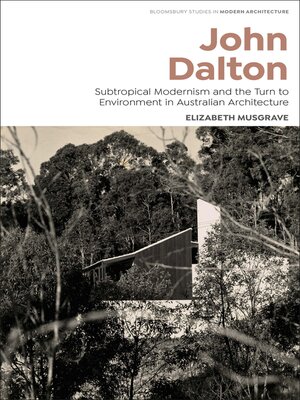John Dalton
ebook ∣ Subtropical Modernism and the Turn to Environment in Australian Architecture · Bloomsbury Studies in Modern Architecture
By Elizabeth Musgrave

Sign up to save your library
With an OverDrive account, you can save your favorite libraries for at-a-glance information about availability. Find out more about OverDrive accounts.
Find this title in Libby, the library reading app by OverDrive.



Search for a digital library with this title
Title found at these libraries:
| Library Name | Distance |
|---|---|
| Loading... |
This book addresses the work of architect John Dalton (1927-2007), an important voice in mid-century modernism in Australia whose work, despite his being exhibited and published internationally and also winning several awards for his designs, is woefully little known.
Published as part of the Bloomsbury Studies in Modern Architecture series, which brings to light the work of significant yet overlooked modernist architects, the book draws on previously unpublished archival documents, including Dalton's drawings and paintings, transcripts of lectures, letters and articles, plans and photographic images of built works, to characterize the architect not only as a very talented designer, but also as a pioneer of environmentalist thinking in Australia.
The book reveals how Dalton's architectural preoccupations parallel a transition in mid-century modern architecture globally from functional efficiency and material rationalism, to a concern with being in dialogue with the environment, confirming a wider 'environmental turn' that involved the integration of environmental with cultural considerations through relational thinking, and which preceded and transcends the discipline's fascination with theoretical paradigms such as Critical Regionalism.
John Dalton: Subtropical Modernism and the Turn to Environment in Australian Architecture is thus not only an important contribution to the existing scholarship on 20th century modernism, but also to the current renewed interest in environmental design across the globe.
Published as part of the Bloomsbury Studies in Modern Architecture series, which brings to light the work of significant yet overlooked modernist architects, the book draws on previously unpublished archival documents, including Dalton's drawings and paintings, transcripts of lectures, letters and articles, plans and photographic images of built works, to characterize the architect not only as a very talented designer, but also as a pioneer of environmentalist thinking in Australia.
The book reveals how Dalton's architectural preoccupations parallel a transition in mid-century modern architecture globally from functional efficiency and material rationalism, to a concern with being in dialogue with the environment, confirming a wider 'environmental turn' that involved the integration of environmental with cultural considerations through relational thinking, and which preceded and transcends the discipline's fascination with theoretical paradigms such as Critical Regionalism.
John Dalton: Subtropical Modernism and the Turn to Environment in Australian Architecture is thus not only an important contribution to the existing scholarship on 20th century modernism, but also to the current renewed interest in environmental design across the globe.







